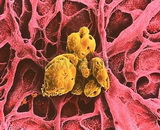Bladder Urolithiasis (BU)
Bladder stone

Bladder stones are small mineral deposits that can form in the bladder. In most cases bladder stones develop when the urine becomes very concentrated or when one is dehydrated. This allows for minerals, such as calcium or magnesium salts, to crystallize and form stones. Bladder stones vary in number, size and consistency. In some cases bladder stones do not cause any symptoms and are discovered as an incidental finding on a plain radiograph. However, when symptoms do occur, these may include severe lower abdominal and back pain, difficult urination, frequent urination at night, fever, painful urination andblood in the urine. The majority of individuals who are symptomatic will complain of pain which comes in waves. The pain may also be associated with nausea, vomiting and chills.
Organism species: Mus musculus (Mouse)
- Disease model DSI635Mu01 Mouse Model for Bladder Urolithiasis (BU) In Stock
- Customized Service n/a Tissue of Bladder Urolithiasis (BU) (If Necessary) Tissue Customized Service Offer
- Customized Service n/a Serums of Bladder Urolithiasis (BU) (If Necessary) Serums Customized Service Offer
Organism species: Rattus norvegicus (Rat)
- Disease model DSI635Ra01 Rat Model for Bladder Urolithiasis (BU) In Stock
- Customized Service n/a Tissue of Bladder Urolithiasis (BU) (If Necessary) Tissue Customized Service Offer
- Customized Service n/a Serums of Bladder Urolithiasis (BU) (If Necessary) Serums Customized Service Offer
Organism species: Cavia (Guinea pig )
- Disease model DSI635Gu01 Cavia Model for Bladder Urolithiasis (BU) In Stock
- Customized Service n/a Tissue of Bladder Urolithiasis (BU) (If Necessary) Tissue Customized Service Offer
- Customized Service n/a Serums of Bladder Urolithiasis (BU) (If Necessary) Serums Customized Service Offer
Organism species: Oryctolagus cuniculus (Rabbit)
- Disease model DSI635Rb01 Rabbit Model for Bladder Urolithiasis (BU) In Stock
- Customized Service n/a Tissue of Bladder Urolithiasis (BU) (If Necessary) Tissue Customized Service Offer
- Customized Service n/a Serums of Bladder Urolithiasis (BU) (If Necessary) Serums Customized Service Offer
Organism species: Canis familiaris; Canine (Dog)
- Disease model DSI635Ca01 Canine Model for Bladder Urolithiasis (BU) In Stock
- Customized Service n/a Tissue of Bladder Urolithiasis (BU) (If Necessary) Tissue Customized Service Offer
- Customized Service n/a Serums of Bladder Urolithiasis (BU) (If Necessary) Serums Customized Service Offer


